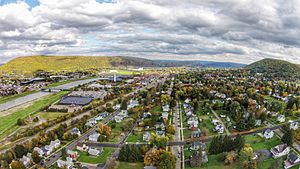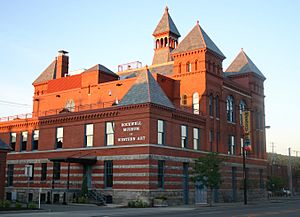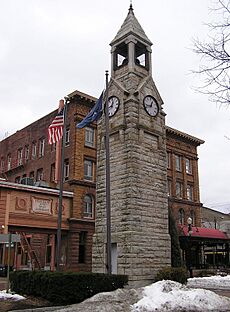Corning, New York facts for kids
Quick facts for kids
Corning, New York
|
||
|---|---|---|
 |
||
|
||
| Nickname(s):
Crystal City
|
||
| Country | United States | |
| State | New York | |
| County | Steuben | |
| Government | ||
| • Type | Council-Manager | |
| Area | ||
| • Total | 3.26 sq mi (8.45 km2) | |
| • Land | 3.08 sq mi (7.99 km2) | |
| • Water | 0.18 sq mi (0.46 km2) | |
| Elevation | 932 ft (284 m) | |
| Population
(2020)
|
||
| • Total | 10,551 | |
| • Density | 3,421.21/sq mi (1,321.04/km2) | |
| Time zone | UTC−5 (Eastern (EST)) | |
| • Summer (DST) | UTC−4 (EDT) | |
| ZIP codes |
14830-14831
|
|
| Area code(s) | 607 | |
| FIPS code | 36-18256 | |
| GNIS feature ID | 0947476 | |
| Website | Corning, New York | |
Corning is a city in Steuben County, New York, United States, on the Chemung River. The population was 10,551 at the 2020 census. It is named for Erastus Corning, an Albany financier and railroad executive who was an investor in the company that developed the community. The city is best known as the headquarters of Fortune 500 company Corning Incorporated, formerly Corning Glass Works, a manufacturer of glass and ceramic products for industrial, scientific and technical uses. Corning is roughly equidistant from New York City and Toronto, being about 220 miles (350 km) from both.
Contents
Overview
The city of Corning is situated at the western edge of the town of Corning and in the southeast part of Steuben County.
It is also home to the Corning Museum of Glass, which houses one of the world's most comprehensive collections of glass objects from antiquity to the present. The museum houses the Rakow Library, one of the world's major glass research centers.
The city's other major cultural attraction is the Rockwell Museum. It contains an important collection of Western American painting and sculpture assembled over the past 40 years by Robert F. and Hertha Rockwell. The city has been cited several times by American Style magazine as one of the top twenty-five small city arts destinations in the U.S. – most recently in June 2010. Many of the cultural events and historic landmarks in the city are in Corning's Gaffer District.
Corning Country Club annually hosted the Corning Classic, a stop on the Ladies Professional Golf Association tour, from 1979 to 2009. The city has commercial air service available at Elmira/Corning Regional Airport in the nearby town of Big Flats.
Corning is also home to the 2006 New York State Class A high school football champions.
In 2006, the city council approved public water fluoridation. In 2007, a petition was launched to ban this practice by local resident Kirk Huttleston which eventually became known as Proposition 1. Proposition 1 passed the ban by a close vote of 1,287 to 1,222, according to unofficial results, leading to a full ban on public water fluoridation in 2008.
In 2013, Rand McNally's list of best small towns in America named Corning the "Most Fun" town out of all the list's finalists.
History
The first settlement in the town of Corning was made near the site of the future city in 1796. The community was incorporated as a village in 1848. Corning was incorporated as a city in 1890. As the glass industry developed, Corning became known as the "Crystal City" which was supported by companies such as Hawkes, Sinclair, and Hunt - which produced some of the finest American Brilliant Period cut glass between 1880 and 1915.
The Corning area's first real industry was lumber. The first settlers used the area's river systems to transport logs and finished lumber in fleets downstream to buyers. This gave rise to large mills which helped to develop the area. Rafting of lumber began to wane as timber was depleted. At one time the mills of the Corning area were reputed to be among the biggest in the world. After the lumber was depleted the great mills moved north to new forests.
East, across the Chemung River from Corning, lies Gibson, the site of a feeder canal for the Chemung Canal system. Some of Corning's early prosperity came from the feeder canal system exposure. Canal cargoes from Corning included soft coal, timber, tobacco, grain, and whiskey. From April 22 to December 11, 1850, the canal season that year, the newspaper reported that 1,116 boats left the port of Corning. Tolls for the year totaled $54,060.39. Among items shipped were 46,572,400 pounds of coal. The canal's best peacetime year was 1854 when 270,978 tons of freight were hauled. The Civil War brought an abnormal amount of business, with a peak of 307,151 tons hauled in one year.
After the Civil War, an industrial boom occurred in the region. Ingersoll Rand opened during this period in Painted Post, just north of Corning.
Corning became a railroad town in the 1880s, many smaller railroad lines busily weaving webs of tracks connecting the major trunk line to smaller communities. In 1912, the Corning train wreck three miles east of Corning in Gibson left 39 dead.
The Jenning's Tavern, Corning Armory, Market Street Historic District, Southside Historic District, World War Memorial Library, and United States Post Office are listed on the National Register of Historic Places.
The flood of 1972
The flood of 1972 was a major event for the area. On June 22, 1972, the storm that had been Hurricane Agnes struck the Southern Tier of New York. The storm combined with a storm system from Ohio to drop six to eight inches (203 mm) of rain in the Chemung River basin. This ultimately overwhelmed the flood control systems of the time, and the Chemung River broke through the dam system on Friday, June 23 at 4:00 a.m. By 9:00 a.m. the river crested and began to recede. In the Corning area, eighteen people were killed and untold millions of dollars of damage was incurred. The river receded within hours, leaving mud which can still be found in basements of homes and businesses in Corning, and there is a section of the Corning Museum of Glass that indicates on the wall how high the flood waters rose.
Geography
Just upstream from Corning, the Cohocton River and the Tioga River merge to form the Chemung River which flows through downtown. The river was an important source of power in the early history, and is part of the attractiveness of the region today.
The river is prone to floods, as rain water runs off quickly from the steep hillsides of the area. In 1972 the remnants of Hurricane Agnes dropped fifteen or more inches of rain in the area within a short time causing extensive flooding. Eighteen people were killed in the immediate Corning-Painted Post area. The entire downtown area was flooded, with severe damage. Flooding is now controlled by a system of dams upstream from Corning.
I-86 (the Southern Tier Expressway), NY 17, NY 352, NY 414, and NY 415 are major highways connecting in Corning. County Road 40 leads into the city from the south and County Road 41 from the north. I-99 and US 15 proceeds southward from Painted Post, west of Corning.
According to the United States Census Bureau, the city has a total area of 3.3 square miles (8.5 km2), of which, 3.1 square miles (8.1 km2) of it is land and 0.2 square miles (0.4 km2) of it (5.18%) is water.
Climate
| Climate data for Corning, New York (1991–2020 normals, extremes 1992–present) | |||||||||||||
|---|---|---|---|---|---|---|---|---|---|---|---|---|---|
| Month | Jan | Feb | Mar | Apr | May | Jun | Jul | Aug | Sep | Oct | Nov | Dec | Year |
| Record high °F (°C) | 66 (19) |
71 (22) |
86 (30) |
91 (33) |
94 (34) |
95 (35) |
98 (37) |
100 (38) |
97 (36) |
84 (29) |
76 (24) |
69 (21) |
100 (38) |
| Mean daily maximum °F (°C) | 29.5 (−1.4) |
32.6 (0.3) |
41.5 (5.3) |
55.2 (12.9) |
67.6 (19.8) |
74.9 (23.8) |
79.1 (26.2) |
77.2 (25.1) |
70.1 (21.2) |
57.7 (14.3) |
44.9 (7.2) |
34.2 (1.2) |
55.4 (13.0) |
| Daily mean °F (°C) | 20.8 (−6.2) |
22.7 (−5.2) |
30.5 (−0.8) |
42.9 (6.1) |
54.6 (12.6) |
62.8 (17.1) |
67.1 (19.5) |
65.6 (18.7) |
58.4 (14.7) |
46.9 (8.3) |
35.8 (2.1) |
26.7 (−2.9) |
44.6 (7.0) |
| Mean daily minimum °F (°C) | 12.2 (−11.0) |
12.8 (−10.7) |
19.6 (−6.9) |
30.5 (−0.8) |
41.6 (5.3) |
50.6 (10.3) |
55.1 (12.8) |
54.0 (12.2) |
46.7 (8.2) |
36.2 (2.3) |
26.6 (−3.0) |
19.2 (−7.1) |
33.8 (1.0) |
| Record low °F (°C) | −20 (−29) |
−18 (−28) |
−15 (−26) |
6 (−14) |
22 (−6) |
33 (1) |
39 (4) |
41 (5) |
26 (−3) |
20 (−7) |
−1 (−18) |
−13 (−25) |
−20 (−29) |
| Average precipitation inches (mm) | 2.34 (59) |
1.92 (49) |
2.99 (76) |
3.37 (86) |
3.05 (77) |
4.18 (106) |
3.69 (94) |
3.86 (98) |
4.18 (106) |
3.60 (91) |
2.85 (72) |
2.66 (68) |
38.69 (983) |
| Average snowfall inches (cm) | 11.8 (30) |
11.3 (29) |
13.6 (35) |
2.2 (5.6) |
0.0 (0.0) |
0.0 (0.0) |
0.0 (0.0) |
0.0 (0.0) |
0.0 (0.0) |
0.2 (0.51) |
4.1 (10) |
10.0 (25) |
53.2 (135) |
| Average precipitation days (≥ 0.01 in) | 14.8 | 11.8 | 13.3 | 14.1 | 14.0 | 13.6 | 12.7 | 12.2 | 11.6 | 14.2 | 13.6 | 15.3 | 161.2 |
| Average snowy days (≥ 0.1 in) | 11.1 | 9.4 | 7.1 | 1.9 | 0.0 | 0.0 | 0.0 | 0.0 | 0.0 | 0.2 | 3.5 | 8.7 | 41.9 |
| Source: NOAA | |||||||||||||
Demographics
As of the census of 2010, there were 11,183 people in 5,114 households residing in the city. The population density was 3,626.1 inhabitants per square mile (1,400.0/km2). There were 5,519 housing units. The racial makeup of the city was 91.8% White, 3.2% Black or African American, 0.3% Native American, 1.8% Asian, Hispanic or Latino of any race were 2.4% of the population. 4.1% speak a language other than English at home.
In 2000, there were 4,996 households, out of which 26.2% had children under the age of 18 living with them, 37.6% were married couples living together, 12.3% had a female householder with no husband present, and 46.6% were non-families. 40.1% of all households were made up of individuals, and 15.5% had someone living alone who was 65 years of age or older. The average household size was 2.14 and the average family size was 2.89.
In the city, the population was spread out, with 23.3% under the age of 18, 8.6% from 18 to 24, 29.2% from 25 to 44, 21.1% from 45 to 64, and 17.8% who were 65 years of age or older. The median age was 38 years. For every 100 females, there were 87.5 males. For every 100 females age 18 and over, there were 83.5 males.
The median income for a household in the city was $32,780, and the median income for a family was $46,674. Males had a median income of $39,805 versus $27,489 for females. The per capita income for the city was $22,056. About 9.1% of families and 13.0% of the population were below the poverty line, including 18.4% of those under age 18 and 3.8% of those age 65 or over. In 2010, 20.4% were below the poverty line.
| Historical population | |||
|---|---|---|---|
| Census | Pop. | %± | |
| 1870 | 4,018 | — | |
| 1880 | 4,802 | 19.5% | |
| 1890 | 8,590 | 78.9% | |
| 1900 | 11,061 | 28.8% | |
| 1910 | 13,730 | 24.1% | |
| 1920 | 15,820 | 15.2% | |
| 1930 | 15,777 | −0.3% | |
| 1940 | 16,212 | 2.8% | |
| 1950 | 17,684 | 9.1% | |
| 1960 | 17,085 | −3.4% | |
| 1970 | 15,792 | −7.6% | |
| 1980 | 12,953 | −18.0% | |
| 1990 | 11,938 | −7.8% | |
| 2000 | 10,842 | −9.2% | |
| 2010 | 11,183 | 3.1% | |
| 2020 | 10,551 | −5.7% | |
| Sources: 1790–1950, 1960–1980, 1990–2000 |
|||
Education
The Corning-Painted Post (Consists of the City of Corning, and the Village of Painted Post) School District currently has six public elementary schools, one public middle school, and one public high school located in the greater Corning area.
In 2010 a referendum was passed that reconfigured the school district's secondary schools; both of the previous middle schools combined and moved into the former "West High School" building while both of the high schools combined at the former "East High School" campus. This reconfiguration / building project was finished by the beginning of the 2014–2015 school year.
In addition to the public and private school options, the Corning-Painted Post District also partners with a regional P-Tech school (known as "The Greater Southern Tier STEM Academy") and sends selected students to a grade 9-14 program on their campus.
Public elementary schools include:
- Calvin U. Smith
- Erwin Valley
- Frederick Carder
- Hugh W. Gregg
- Lindley-Presho (closed)
- William E. Severn
- Winfield Street
Public middle schools include:
- Corning Free Academy (Before 2014–2015 school year)
- Corning Painted Post Middle School (After 2013–current)
- Northside Blodgett (Before 2014–2015 school year)
Public high schools include:
- Corning Painted Post High School (After 2013–current)
- East High School (Before 2014–2015 school year)
- High School Learning Center (HSLC)
- West High School (Before 2014–2015 school year)
Private schools in Corning include:
- All Saints Academy (a preK–8 Catholic school)(Closed)
- Corning Christian Academy (a P–12 evangelical Christian school)
- The Alternative School for Math and Science (ASMS)
Higher education in Corning includes:
- Corning Community College
Places of interest
Downtown
- Corning Museum of Glass: a not-for-profit museum dedicated to the art, history, science, and craft of glass.
- The Gaffer District is the historic heart of Corning, featuring restored buildings, shopping, dining, and events through the year.
- Market Street is Corning's historic main street, lined with restaurants and shopping.
- The heart of Market Street is Centerway Square, a pedestrianized central square with a covered bandstand and public benches for public concerts and events. A restored historic clock tower serves as Centerway Square's focal point.
Elsewhere in Corning
- Bloody Run – An area near Gorton Creek, it was the site of a battle between forces of American generals John Sullivan and James Clinton and Native American villagers. This battle was part of a campaign directly ordered by George Washington to break the control of the Iroquois Indians in the area. It was called Bloody Run for the reports of bloody creek water coming from the battle scene.
- Chimney Rocks – A group of tall rock formations that stood east of Corning. The rocks are no longer there but were so named because they were tall and narrow like chimneys.
- Heritage Village of the Southern Finger Lakes – Right in the heart of Corning, the Heritage Village is a Living History museum and the site of the Benjamin Patterson Inn, constructed in 1796 to draw settlers to the area. The site also includes a functioning blacksmith shop, one room school house, and an 1850s era log cabin.
- Horace D. Page Tunnel – A tunnel connecting the two divided areas of Denison Park, located on the city's South side. It was named after Page, who lost the naming rights to Elmira's Millers (formerly Page's) Pond in a 1912 horse racing bet at Tioga Downs, and was given naming rights to the tunnel as compensation.
Gallery
Notable people
- Alanson B. Houghton, United States Congressman
- Amory "Amo" Houghton Jr., politician
- Amory Houghton, United States ambassador
- Caroline Ella Heminway Kierstead, geologist
- Charles C. B. Walker, United States Congressman
- Christi Wolf, champion female bodybuilder and professional wrestler best known for her stint in World Championship Wrestling
- Duane Eddy (1938–2024), Grammy Award-winning guitarist
- Edd Hall, US television personality, announcer
- Eric Massa, United States Congressman
- Frederick Carder, glass artist
- Greg Keagle, MLB player
- Harvey Littleton, glass artist
- James R. Houghton, chairman of Corning Inc.
- John N. Hungerford, United States Congressman
- John Tillman, head lacrosse coach, University of Maryland, College Park
- Joseph Costa, aviation pioneer
- Katharine Houghton Hepburn (1878–1951), social activist, mother of Katharine Hepburn
- Samuel Sevian, chess prodigy, youngest Grandmaster US chess history
- Thomas S. Buechner (1926–2010), founding director of Corning Museum of Glass
- Tom Reed, United States Congressman
Sister cities
 Kakegawa, Shizuoka, Japan (formerly Osuka which was annexed by Kakegawa)
Kakegawa, Shizuoka, Japan (formerly Osuka which was annexed by Kakegawa) Lviv, Ukraine
Lviv, Ukraine San Giovanni Valdarno, Tuscany, Italy
San Giovanni Valdarno, Tuscany, Italy
See also
 In Spanish: Corning (Nueva York) para niños
In Spanish: Corning (Nueva York) para niños










